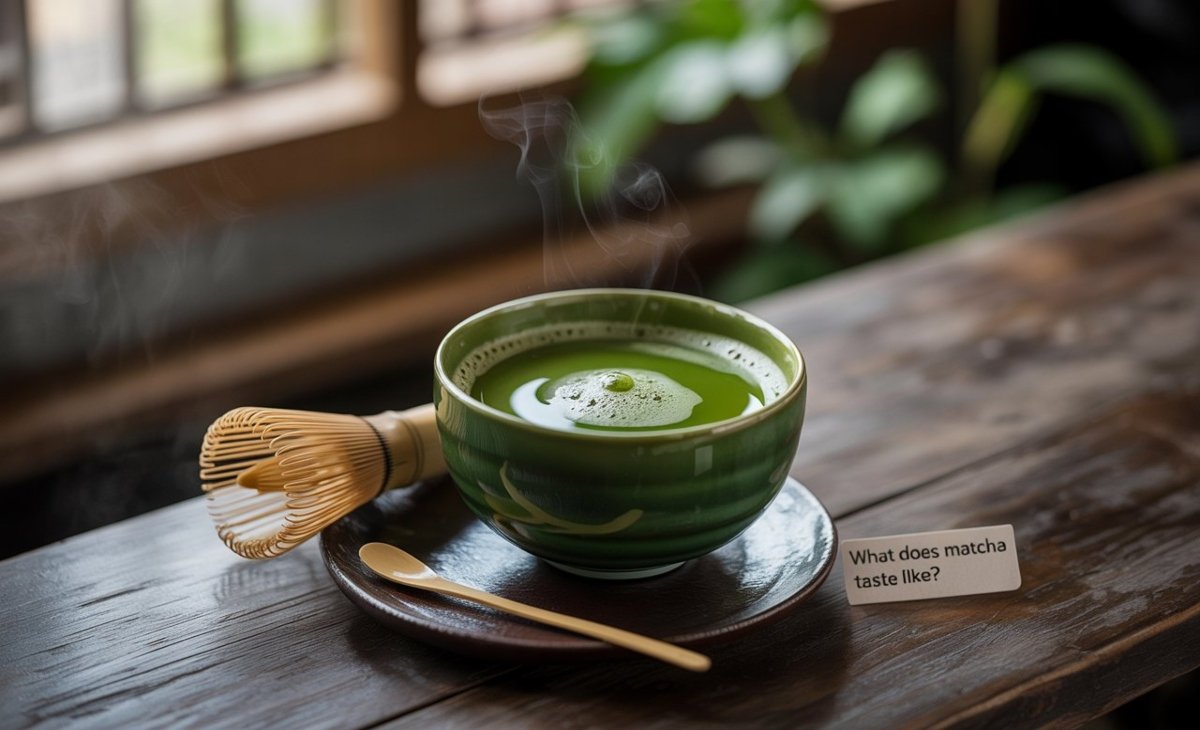If you’ve ever ordered a matcha latte or seen that vibrant green powder on Instagram, you’ve probably asked yourself: what does matcha taste like? For newcomers, the flavor can be puzzling—sometimes smooth and sweet, other times grassy and slightly bitter. Matcha’s taste is unlike any other tea because you’re drinking the entire ground leaf rather than just an infusion. That means it delivers a bold, layered flavor with a complexity all its own.
In this guide, we’ll explore what matcha really tastes like, how quality and preparation affect the flavor, and the best ways to enjoy it—whether in lattes, smoothies, or desserts.
What Does Matcha Taste Like at Its Core?
At its heart, matcha offers a balance of earthy, grassy notes, gentle sweetness, a touch of bitterness, and a creamy umami finish. Unlike black or green tea, matcha is richer and more intense. The powdered leaf coats your palate, leaving a smooth mouthfeel that many describe as almost buttery.
However, the flavor depends on the grade:
- Ceremonial grade: High-quality matcha used for traditional tea ceremonies. It’s smooth, slightly sweet, and full of umami with minimal bitterness.
- Culinary grade: Commonly used in lattes, baked goods, and smoothies. It has a stronger grassy taste, more bitterness, and a robust character that pairs well with other ingredients.
Factors That Shape Matcha’s Flavor
Not all matcha tastes the same. Several factors can dramatically affect your experience:
1. Origin and Quality
Authentic Japanese matcha, especially from regions like Uji or Nishio, tends to have a deeper, well-balanced flavor. Lower-quality matcha often tastes overly bitter or astringent.
2. Freshness
Matcha loses its flavor quickly when exposed to air or light. Fresh matcha has a vibrant green color and a clean, smooth taste, while older matcha turns dull and tastes harsh.
3. Preparation
Water that’s too hot or improper whisking can ruin matcha’s delicate flavors. Ideally, use water around 160–175°F and whisk until frothy to bring out its natural sweetness.
How to Prepare Matcha for the Best Taste
Getting the most out of matcha’s flavor isn’t complicated, but a few techniques make a big difference:
- Sift the powder before whisking to avoid clumps.
- Use the right temperature water—never boiling.
- Whisk in a zig-zag motion with a bamboo whisk (chasen) to create a creamy froth.
This preparation enhances matcha’s umami and reduces bitterness, leaving a smooth, balanced taste.
What Does Matcha Taste Like in Different Forms?
One of the joys of matcha is its versatility. Depending on how you use it, the flavor changes dramatically.
Matcha Latte
Creamy, smooth, and comforting. Milk (dairy or plant-based) softens matcha’s bitterness, while sweeteners enhance its natural earthiness. This is the most popular introduction to matcha in the West.
Matcha Smoothie
Fresh and energizing. When blended with fruits like banana or mango, the matcha taste becomes milder, with subtle earthy undertones. It’s refreshing and nutritious.
Matcha Desserts
From cookies and cakes to ice cream, matcha adds a sophisticated twist. Its slight bitterness balances sweetness, creating depth and a beautiful green color that makes desserts stand out.
Why People Love the Taste of Matcha
The first sip of matcha can surprise newcomers, but many quickly fall in love with its complex flavor. The balance of grassy freshness, gentle sweetness, and creamy umami is unlike any other drink. Plus, once you learn the right preparation methods, bitterness becomes less of a concern.
Beyond taste, people also appreciate the health benefits of matcha:
- Steady, calm energy from natural caffeine and L-theanine.
- Rich antioxidants that support overall health.
- A detoxifying effect thanks to chlorophyll.
In other words, the unique flavor isn’t the only reason matcha has such a loyal following.
Tips for Enjoying Matcha at Home
- Start with a latte if you’re new. The milk balances flavors and makes it more approachable.
- Experiment with recipes. Try smoothies, baked goods, or even savory dishes with matcha.
- Invest in quality. Good matcha may cost more, but the taste difference is worth it.
- Store properly. Keep matcha in an airtight container away from light and heat to preserve freshness.
Final Words
So, what does matcha taste like? At its best, it’s a smooth blend of grassy earthiness, gentle sweetness, subtle bitterness, and rich umami. While the flavor may seem strong at first, many people grow to love its unique character—especially when prepared properly or enjoyed in lattes, desserts, and smoothies.
Whether you’re curious about its taste, interested in its health benefits, or simply want to try a new drink, matcha offers a one-of-a-kind experience worth exploring. Grab a whisk, experiment with recipes, and find the way you like it best.
Common Questions About Matcha’s Taste
Is matcha bitter?
High-quality ceremonial matcha is not overly bitter—it’s smooth and slightly sweet. Bitterness is more common in lower-quality or improperly prepared matcha.
Does matcha taste like regular green tea?
They’re related, but not the same. Green tea is lighter and more delicate, while matcha is richer, creamier, and more intense because you consume the whole leaf.
Can I make matcha taste sweeter?
Yes. Adding milk, honey, or natural sweeteners balances its earthiness without overwhelming the flavor. Choosing ceremonial grade matcha also ensures a naturally sweeter taste.





